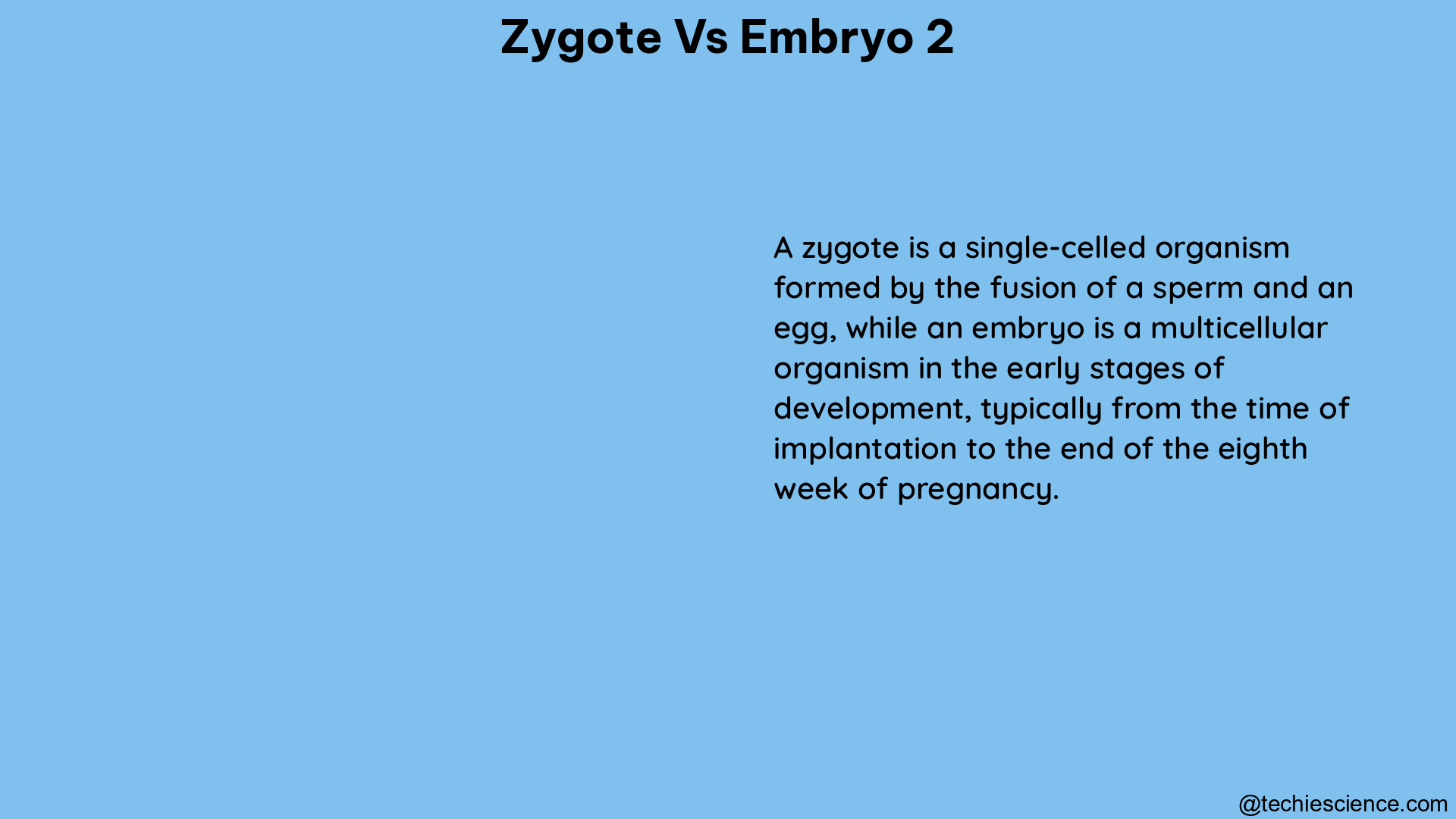A zygote is a single cell that results from the fertilization of an egg by a sperm, while an embryo is a multicellular organism in its early stages of development. In the context of in vitro fertilization (IVF), the distinction between a zygote and an embryo is often made on the second day after fertilization.
The Zygote Stage
The zygote is the initial cell formed when a sperm fertilizes an egg. This single-celled organism contains the complete genetic information necessary for the development of a new individual. The zygote undergoes a series of rapid cell divisions, known as cleavage, to form a morula and then a blastocyst.
Characteristics of the Zygote
- Genetic Composition: The zygote contains a unique combination of genetic material from both the sperm and the egg, with 46 chromosomes (23 from each parent).
- Cell Division: The zygote undergoes its first cell division approximately 24 hours after fertilization, resulting in a two-cell embryo.
- Totipotency: The cells of the zygote are totipotent, meaning they have the potential to differentiate into any cell type in the body, including the placenta and other extraembryonic tissues.
- Morphological Changes: The zygote undergoes a series of morphological changes, including the distribution of nucleoli and the appearance of the cytoplasm, which are important factors in predicting the developmental potential of the embryo.
The Embryo Stage

On the second day after fertilization, the zygote undergoes its first cell division and becomes a two-cell embryo. At this stage, the embryo is still in the early stages of development and is highly sensitive to its environment.
Characteristics of the Embryo
- Cell Division: The two-cell embryo undergoes further cell divisions, resulting in a four-cell, eight-cell, and eventually a morula (16-32 cells) and a blastocyst (50-100 cells).
- Differentiation: As the embryo develops, its cells begin to differentiate into the various cell types that will form the different tissues and organs of the body.
- Morphological Evaluation: The morphology and growth rate of the embryo on the second day are strong predictors of its developmental potential. Researchers have developed scoring systems to evaluate the quality of the embryo based on these factors.
- Sensitivity to Environment: The early-stage embryo is highly sensitive to its environment, and factors such as temperature, pH, and nutrient availability can significantly impact its development.
Embryo Scoring and Selection
Researchers have developed a formula to convert qualitative embryo grading to a quantitative ranking, which can improve the accuracy of embryo selection for IVF. The scoring criteria of embryo selection are based on serial morphological observations conducted on day 1 (during the assessment of fertilization), on days 2 and 3 after fertilization.
Factors Considered in Embryo Scoring
- Zygote Morphology: The distribution of nucleoli and appearance of cytoplasm in the zygote are important factors in predicting the developmental potential of the embryo.
- Cleavage Rate: The further development up to the first cleavage division is also introduced into the embryo scoring system.
- Embryo Morphology: Factors such as the number of blastomeres, the degree of fragmentation, and the symmetry of the embryo are evaluated.
- Blastocyst Formation: The ability of the embryo to develop into a blastocyst is also considered in the scoring system, as it is a strong indicator of the embryo’s developmental potential.
Relationship between Zygote and Embryo Development
In a study of 1000 zygotes obtained during 262 attempts, 170 presented cleavage arrest, 42 spontaneously degenerated, and 787 developed into cleaved embryos. This highlights the complex relationship between the zygote pattern and subsequent embryonic development, which is influenced by many factors.
Conclusion
The distinction between a zygote and an embryo is an important one in the context of IVF. The morphology, growth rate, and distribution of nucleoli and cytoplasm in the zygote and embryo on the second day after fertilization are strong predictors of the embryo’s developmental potential. The use of quantitative scoring systems and formulae can improve the accuracy of embryo selection for IVF, ultimately increasing the chances of successful implantation and pregnancy.
References:
– P De Sutter et al, High outcome predictability after IVF using a combined score for zygote and embryo morphology and growth rate. Human Reproduction. (2002).
– Medical Xpress, Researchers develop formula to convert qualitative embryo grading to a quantitative ranking. (2023-05-03).
– A. Scott, Embryo selection for assisted conception. Human Reproduction Update. (1999) 5, 281–292.
– M. Veeck, Pronuclear scoring as a predictor of embryo development. Fertility and Sterility. (1988) 49, 791–796.

The lambdageeks.com Core SME Team is a group of experienced subject matter experts from diverse scientific and technical fields including Physics, Chemistry, Technology,Electronics & Electrical Engineering, Automotive, Mechanical Engineering. Our team collaborates to create high-quality, well-researched articles on a wide range of science and technology topics for the lambdageeks.com website.
All Our Senior SME are having more than 7 Years of experience in the respective fields . They are either Working Industry Professionals or assocaited With different Universities. Refer Our Authors Page to get to know About our Core SMEs.